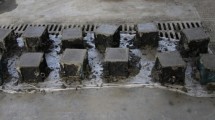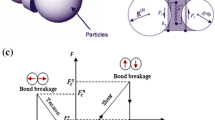Abstract
Estimating the shear mechanical parameters of field-scale joints using laboratory tested results is a challenging task due to the scale effect. To further understand the effect of specimen size on shear mechanical parameters, this study not only focuses on the joint length effect, but also explores the effect of specimen height (the dimension in the direction perpendicular to the joint surface), while the latter has not been paid enough attention in the existing studies. Based on the particle discrete element method, numerical direct shear experiments are carried out for multiple specimen height and joint length conditions. The effects of specimen height and joint length on the pre-peak, peak and post-peak shear deformation stages are analyzed in detail. The results suggest that specimen height also has an effect on the shear mechanical parameters of the joints. In the pre-peak deformation stage, the specimen height effect on shear stiffness is diametrically opposed to that of joint length, while the effect on shear strength is similar to that of joint length. In the post-peak crack evolution stage, the specimen height effect also differs from the joint length effect. In terms of significance, the effects of specimen height and joint length on the same shear mechanical parameter are almost at the same level. Therefore, future experimental studies may need to pay more attention to the specimen height effect.















Similar content being viewed by others
References
Meng F, Zhou H, Wang Z, Zhang L, Kong L, Li S, Zhang C (2016) Experimental study on the prediction of rockburst hazards induced by dynamic structural plane shearing in deeply buried hard rock tunnels. Int J Rock Mech Min Sci 86:210–223. https://doi.org/10.1016/j.ijrmms.2016.04.013
Yang X, Sun D, Jing H (2020) Morphological features of shear-formed fractures developed in a rock bridge. Eng Geol 278(5):105833. https://doi.org/10.1016/j.enggeo.2020.105833
Cheng Y, Song Z, Yang T, Han J, Wang B, Zhang Z (2022) Investigating the aging damage evolution characteristics of layered hard sandstone using digital image correlation. Constr Build Mater 353:128828. https://doi.org/10.1016/j.conbuildmat.2022.128838
Pratt HR, Black AD, Braze WF (1974) Friction and deformation of jointed quartz diorite. In: Proceedings of 3rd ISRM conference, Denver, USA, 2A, pp 306–310
Barton N, Bandis S (1982) Effect of block size on the shear behavior of jointed rock. In: Proceedings of the 23rd symposium on rock mechanics, Berkeley, pp 739–760
Bandis S, Lumsden AC, Barton N (1981) Experimental studies of scale effect on the shear behaviour of rock joints. Int J Rock Mech Min Sci Geomech Abstr 20:249–268. https://doi.org/10.1016/0148-9062(81)90262-X
Cunha A (1991) Scale effect in rock mechanics. In: Proceedings of 1st international conference on scale effect in rock masses, Loen, Norway, pp 3–27
Giani GP, Ferero AM, Passarello G, Reinaudo L (1992) Scale effect evaluation on natural discontinuity shear strength. In: Proceedings of the regional confernce on fractured and jointed rock masses, Lake Tahoe, pp 447–452
Barton N (1976) The shear strength of rock and rock joints. Int J Rock Mech Min Sci Geomech Abstr 13(9):255–279. https://doi.org/10.1016/0148-9062(76)90003-6
Fardin N, Stephansson O, Jing L (2001) The scale dependence of rock joint surface roughness. Int J Rock Mech Min Sci 38(5):659–669. https://doi.org/10.1016/S1365-1609(01)00028-4
Ueng TS, Jou YJ, Peng IH (2010) Scale effect on shear strength of computer-aided-manufactured joints. J Geoeng 5(2):29–37. https://doi.org/10.6310/jog.2010.5(2).1
Vallier F, Mitani Y, Boulon M, Esaki T, Pellet F (2010) A shear model accounting scale effect in rock joints behavior. Rock Mech Rock Eng 43(5):581–595. https://doi.org/10.1007/s00603-009-0074-9
Du S, Huang M, Luo Z, Jia R (2010) Similar material study of mechanical prototype test of rock structural plane. Chin J Rock Mech Eng 29(11):2263–2270 ((In Chinese))
Huang M, Du S, Luo Z, Ni X (2013) Study of shear strength characteristics of simulation rock structural planes based on multi-size direct shear tests. Rock Soil Mech 34(11):3180–3186 ((In Chinese))
Huang M, Hong C, Du S, Luo Z (2020) Experimental technology for the shear strength of the series-scale rock joint model. Rock Mech Rock Eng 53:5677–5695. https://doi.org/10.1007/s00603-020-02241-w
Huang M, Hong C, Ma C, Luo Z, Du S, Yang F (2020) A new representative sampling method for series size rock joint surfaces. Sci Rep 10(1):9129. https://doi.org/10.1038/s41598-020-66047-0
Huang M, Xia C, Ma C (2019) A progressive coverage statistical method for series scales three-dimensional morphology of rock joints. Chin J Rock Mech Eng 38(8):1533–1541 ((In Chinese))
Bahaaddini M, Hagan PC, Mitra R, Hebblewhite BK (2014) Scale effect on the shear behaviour of rock joints based on a numerical study. Eng Geol 181:212–223. https://doi.org/10.1016/j.enggeo.2014.07.018
Tang C (1997) Numerical simulation of progressive rock failure and associated seismicity. Int J Rock Mech Min Sci 34(2):249–261. https://doi.org/10.1016/S0148-9062(96)00039-3
Fang Z, Harrison JP (2002) Development of a local degradation approach to the modelling of brittle fracture in heterogeneous rocks. Int J Rock Mech Min Sci 39(4):443–457. https://doi.org/10.1016/S1365-1609(02)00035-7
Cundall PA, Hart RD (1992) Numerical modelling of discontinua. Eng Comput 9(2):101–113. https://doi.org/10.1108/eb023851
Zhuang X, Chun J, Zhu H (2014) A comparative study on unfilled and filled crack propagation for rock-like brittle material. Theoret Appl Fract Mech 72(1):110–120. https://doi.org/10.1016/j.tafmec.2014.04.004
Zhang W, Dai B, Liu Z, Zhou C (2016) Modeling discontinuous rock mass based on smoothed finite element method. Comput Geotech 79:22–30. https://doi.org/10.1016/j.compgeo.2016.05.020
Abdelaziz A, Zhao Q, Grasselli G (2018) Grain based modelling of rocks using the combined finite-discrete element method. Comput Geotech 103:73–81. https://doi.org/10.1016/j.compgeo.2018.07.003
Bahaaddini M, Sharrock G, Hebblewhite BK (2013) Numerical direct shear tests to model the shear behaviour of rock joints. Comput Geotech 51:101–115. https://doi.org/10.1016/j.compgeo.2013.02.003
Wang X, Yuan W, Yan Y, Zhang X (2020) Scale effect of mechanical properties of jointed rock mass: a numerical study based on particle flow code. Geomech Eng 21(3):259–268. https://doi.org/10.12989/gae.2020.21.3.259
Wu N, Liang Z, Zhou J, Zhang Y (2020) Energy evolution characteristics of coal specimens with preformed holes under uniaxial compression. Geomech Eng 20(1):55–66. https://doi.org/10.12989/gae.2019.18.6.627
Yan YT, Wang SW (2022) Simulation investigation of mechanical and failure characteristics of jointed rock with different shapes of joint asperities under compression loading. Comput Part Mech. https://doi.org/10.1007/s40571-022-00477-7
Xie L, Jin P, Su TC, Li X, Liang Z (2019) Numerical simulation of uniaxial compression tests on layered rock specimens using the discrete element method. Comput Part Mech 7(4):753–762. https://doi.org/10.1007/s40571-019-00307-3
Potyondy DO (2015) The bonded-particle model as a tool for rock mechanics research and application: current trends and future directions. Geosyst Eng 18(1):1–28. https://doi.org/10.1080/12269328.2014.998346
Asadi M, Rasouli V, Barla G (2012) A bonded particle model simulation of shear strength and asperity degradation for rough rock fractures. Rock Mech Rock Eng 45(5):649–675. https://doi.org/10.1007/s00603-012-0231-4
Itasca Consulting Group Inc. (2014) PFC (particle flow code), version 5.0. ICG, Minneapolis, Minnesota, U.S.A. http://www.itascacg.com/software/pfc
Meng F, Song J, Yue Z, Zhou H, Wang X, Wang Z (2022) Failure mechanisms and damage evolution of hard rock joints under high stress: Insights from PFC2D modeling. Eng Anal Bound Elem 135:394–411. https://doi.org/10.1016/j.enganabound.2021.12.007
Acknowledgements
This research is supported by the Fundamental Research Funds for the Central Universities (Grant No. 3205002107D) and the Postgraduate Research & Practice Innovation Program of Jiangsu Province (No. KYCX20-0117).
Author information
Authors and Affiliations
Corresponding author
Ethics declarations
Conflict of interest
The authors declare that they have no conflict of interest.
Additional information
Publisher's Note
Springer Nature remains neutral with regard to jurisdictional claims in published maps and institutional affiliations.
Rights and permissions
Springer Nature or its licensor (e.g. a society or other partner) holds exclusive rights to this article under a publishing agreement with the author(s) or other rightsholder(s); author self-archiving of the accepted manuscript version of this article is solely governed by the terms of such publishing agreement and applicable law.
About this article
Cite this article
Yuan, W., Min, M. Investigation on the scale dependence of shear mechanical behavior of rock joints using DEM simulation. Comp. Part. Mech. 10, 1613–1627 (2023). https://doi.org/10.1007/s40571-023-00577-y
Received:
Revised:
Accepted:
Published:
Issue Date:
DOI: https://doi.org/10.1007/s40571-023-00577-y




